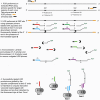A Multiplex PCR/LDR Assay for Viral Agents of Diarrhea with the Capacity to Genotype Rotavirus
- PMID: 30181651
- PMCID: PMC6123451
- DOI: 10.1038/s41598-018-30301-3
A Multiplex PCR/LDR Assay for Viral Agents of Diarrhea with the Capacity to Genotype Rotavirus
Abstract
Rotavirus and noroviruses are major causes of diarrhea. Variable rotavirus vaccination efficacy in Africa and Asia is multifactorial, including the diversity of circulating strains and viral co-infection. We describe a multiplexed assay that detects and genotypes viruses from stool specimens. It includes a one-step reverse transcriptase PCR reaction, a ligase detection reaction (LDR), then hybridization of fluorescent products to micro-beads. In clinical samples it detects rotavirus, caliciviruses (sapovirus and norovirus), mixed infections, and genotypes or genogroups of rotaviruses and noroviruses, respectively. The assay also has the capacity to detect hepatitis A. The assay was validated on reference isolates and 296 stool specimens from the US and Ghana. The assay was 97% sensitive and 100% specific. The genogroup was concordant in 100% of norovirus, and the genotype in 91% and 89% of rotavirus G- and P-types, respectively. Two rare rotavirus strains, G6P[6] and G6P[8], were detected in stool specimens from Ghana. The high-throughput assay is sensitive, specific, and may be of utility in the epidemiological surveillance for rare and emerging viral strains post-rotavirus vaccine implementation.
Conflict of interest statement
The authors declare no competing interests.
Figures



References
-
- World Health Organization. Immunization, Vaccines and Biologicals [cited 2017 Jun 14]. http://www.who.int/immunization/diseases/rotavirus/en/.
Publication types
MeSH terms
Grants and funding
LinkOut - more resources
Full Text Sources
Other Literature Sources
Medical

